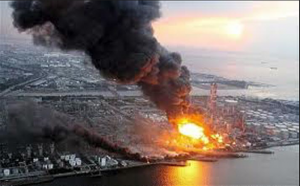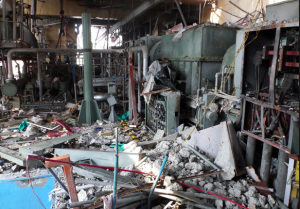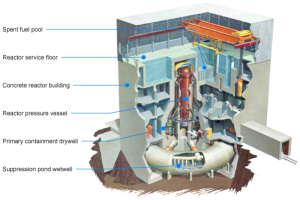Following the Great East Japan Earthquake of magnitude 9.0 at 2.46 pm on March 11, there was considerable damage in the region which was only increased by the large tsunami that was created as a result. “The earthquake was centred 130 km offshore the city of Sendai in Miyagi prefecture on the eastern cost of Honshu Island (the main part of Japan), and was a rare and complex double quake giving a severe duration of about 3 minutes.”. Furthermore, the tsunami destroyed 560 sq km and resulted took the lives of over 19,000 people. There was also a lot of damage to coastal ports and towns, including the destruction and collapsing of over a million buildings.T he Fukushima accident was rated 7 on the INES scale, due to high radioactive releases over days 4 to 6 days.
The area was evacuated by more than 100,000 people for fear of radiation sickness from the nuclear disaster. Moreover, other major issues concerning this event include the highly radioactive water in the basements of reactors 1-3, signifying damage to the reactor pressure vessel. The leakage was not able to be explained but was must likely a result of the reactor core. Also, the evaporated sea water can clog the cooling pipes and weaken the cooling effect, which is concerning.
What happened in the reactors was this:
It began flooding and almost all power was lost along with workers getting killed instantly while the water began entering the station. Then, the cooling system failed and in the now damaged control room, workers found out that the pressure levels were increasing and that they needed to bring the pressure down to prevent disaster. These reactors have pressure release valves that are used to release pressure, the valves were ordered to be opened in order to release pressure into the air. Inside of the plant, however, scientists argued against this plan because if steam were to be released into the air, this steam would carry radioactive material. But, they were under orders and set off to find the valve with only lanterns to guide them. Then, reactor number one exploded from the post quake which dramatically increased radiation levels and two days later, an even larger explosion effects reactor 3, causing radiation levels to rise even higher and when reactor 4 exploded the next day, everything began melting. Then, the three safety measures taken to cool everything failed.
This is in inside of a reactor:
“when the power failed at 3.42 pm, about one hour after shutdown of the fission reactions, the reactor cores would still be producing about 1.5% of their nominal thermal power, from fission product decay – about 22 MW in unit 1 and 33 MW in units 2 & 3. Without heat removal by circulation to an outside heat exchanger, this produced a lot of steam in the reactor pressure vessels housing the cores, and this was released into the dry primary containment (PCV) through safety valves. Later this was accompanied by hydrogen, produced by the interaction of the fuel’s very hot zirconium cladding with steam after the water level dropped.
As pressure started to rise here, the steam was directed into the suppression chamber under the reactor, within the containment, but the internal temperature and pressure nevertheless rose quite rapidly. Water injection commenced, using the various systems provide for this and finally the Emergency Core Cooling System (ECCS). These systems progressively failed over three days, so from early Saturday water injection to the reactor pressure vessel (RPV) was with fire pumps, but this required the internal pressures to be relieved initially by venting into the suppression chamber/ wetwell.”
http://www.world-nuclear.org/info/safety-and-security/safety-of-plants/fukushima-accident/
As a result of this disaster, Japan has been developing new energy strategies. These strategies include the following:
- reducing in the oil-dependency rate to 40% or less by 2030 from the current 50%,
- promotion of nuclear energy, and securing of energy resources abroad through the fostering of more powerful energy companies
- promotion of nuclear energy
- new plants to replace old ones
- the increasing the ratio of “Hinomaru oil”, or oil developed and imported through domestic producers, from the current 15% to 40% by 2030. To achieve that goal, the new strategy emphasizes the need to foster Japanese oil majors that can compete with foreign rivals.
- the restart of reactors
http://www.atimes.com/atimes/Japan/HA13Dh01.html


